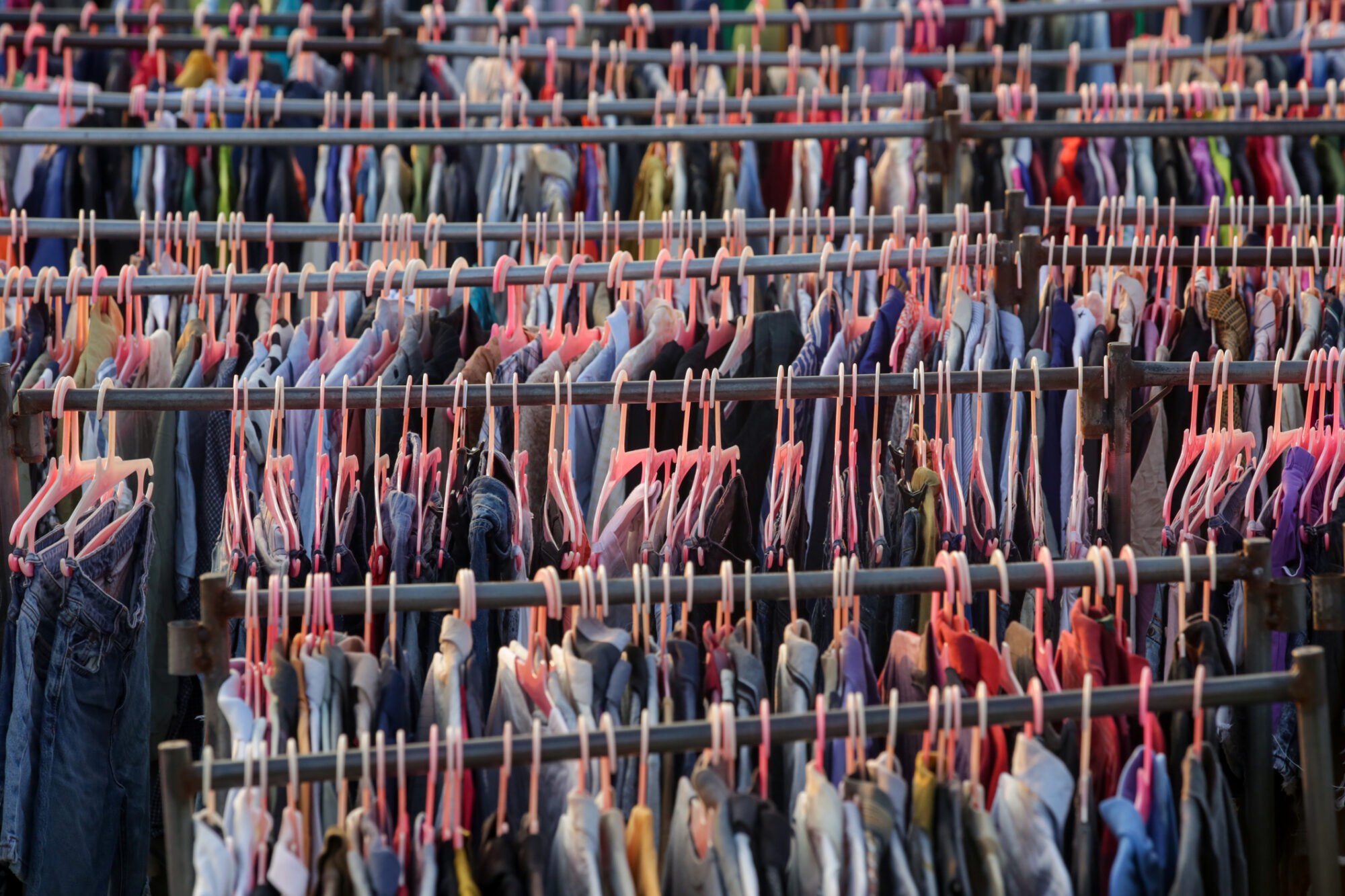The labels on our clothes don’t tell us the full story of their origins. My jumper, made in Bangladesh, could very likely have taken a whistle stop tour around the world once, or even twice, during its manufacture and delivery to my doorstep. These labels also leave out the environmental cost of the way the fashion industry is currently operating.
The term fast fashion refers to low priced clothing, mass produced at high speed in order to keep pace with ever-changing trends. The supply chain is organised to allow new styles to be designed, manufactured and available to purchase within a matter of weeks. Whilst this business model increases the accessibility and reduces the cost of fashionable clothes for the consumer, it comes at a high price for our planet.
The environmental price tag of fast fashion
The necessary steps of this shortened cycle: acquiring the raw materials, preparing and treating them for manufacture, assembling, packaging and delivering the product, are all highly energy intensive. In many cases, each of these steps takes place in different countries, or even continents.
Mirroring the short manufacturing cycle is the equally short lifespan items typically have in our wardrobes. Trend specific garments, often poor quality, are frequently discarded after just a handful of wears, if worn at all. Of the total fibre input used in the manufacture of clothing, 87% ends up in landfill or incinerated. As these textiles are burned, greenhouse gasses such as carbon dioxide and methane, as well as toxins from dyes and chemicals, are released. Overall, the fashion industry is responsible for approximately 10% of global carbon emissions, 20% of global waste water and 35% of primary microplastic released into the environment.

Natural fibres have natural consequences
The negative environmental impact doesn’t end there. Non-renewable fossil fuels form the basis of the raw material used. Every year, 342 million barrels of oil are extracted to produce plastic based textile fibres. And unfortunately, natural fibres are not the environmentally friendly solution you might expect, largely due to the sheer volume of demand. As much as 6% of the world’s pesticides and 16% of insecticides are used to maintain production of the vast quantity of cotton required by the textile industry. More of these water and soil polluting chemicals are used in cotton farming than for any other single crop. Cotton crops also rely heavily on irrigation; for example did you know it takes 2,700 litres of water to make one cotton T-shirt?
Cotton is not the only problematic material. Leather, another popular option, has an immense carbon footprint. It is a by-product of animal agriculture, an industry responsible for 20% of greenhouse gas emissions. Further, animal agriculture is the number one cause of deforestation, mowing down vast areas of forest which act as a carbon sink, absorbing CO2. As such, leather production is directly contributing to the destruction of one of Earth’s most important defences against climate change.
Green is the new black
It is clear that, if we are to salvage what is left of our planet’s healthy ecosystems and keep global warming below the IPCC’s essential target of 1.5°C above pre-industrial levels, the fashion industry must enact changes, and fast. Thankfully, there are a number of signs that suggest the tide is changing against these harmful practices. Throughout September’s fashion month, sustainability has been among the top trends seen on, and off, the catwalk. In Milan, Prada has set a goal of using 90% sustainable fabrics in their designs. In Paris, the French Fashion governing body announced the development of two new tools to measure the environmental impact of collections. And at New York Fashion Week, a panel about the industry’s future was headed by Vogue’s Editor in Chief and certified fashion royalty, Dame Anna Wintour. She brought sustainability to the forefront of the conversation by discussing vintage clothing and urging designers to make “clothes that can last a lifetime” to help “customers understand that clothes are not disposable”. This message, coming from a woman who has made an entire career from reporting on the newest fashion trends, brings hope that green really is the new black.

High-street brands have also been following suit (excuse the pun), with many unveiling ‘conscious’ collections, promising clothes with reduced environmental baggage. Whilst some claims should be treated with scepticism – one study found that 60% of sustainability statements from high-street brands were misleading and unsubstantiated – there are some exciting alternatives to fast fashion to get behind.
PANGAIA, a material science brand, is on a self-proclaimed “mission to save the planet”. Their innovative solutions include grape leather made with waste from the winemaking industry and biodegradable hoodies made of nettles, bamboo and seaweed. Batoko, based on the North West coast of England, collect plastic waste before it reaches landfill and recycle it into high quality swim wear. AYM use bamboo fabric to make timeless, versatile pieces, some of which can be worn in multiple ways, providing three styles in one top. They also organise their manufacturing process to reduce waste. Items are made to order, or available to pre-order, ensuring that everything made is bought. These brands, and many others, are also partnering with a rewilding organisation that are planting trees to offset the carbon emissions from shipping.
As a consumer, it can be difficult to distinguish the green from the green washers. However, you will be pleased to hear there is already an app to help you do so! Good On You does the research and rates brands on their effect on the environment, animals, and people. It also recommends ethical, environmentally-friendly places to shop for whatever your wardrobe is missing, from shoes to pyjamas.
Sustainable fashion for everyone
Using our purchasing power to support sustainable brands and reject fast fashion can have huge impact on how the fashion industry operates in the future. However, having become accustomed to buying a new dress for a tenner, it seems difficult to justify a £90, made-to-order, bamboo number for this weekend’s party. It’s true that this kind of eco-consumerism is a privilege for those with enough time and money. Yet it is equally important to realise that the fast fashion giants are not surviving off people who cannot afford to shop elsewhere; they are thriving in a system of habitual overconsumption. Other alternatives to supporting these brands include clothes swaps with friends, shopping second hand in charity and vintage shops and using reselling platforms such as Depop and Vinted. With just a little thought and effort, becoming a sustainable fashionista can easily be achieved on a budget.
So, for the sake of our planet, on Wednesdays (and every other day) let’s wear green.
If you enjoyed this blog and want to learn more, connect with @TillyatNotch and follow @NotchCom on Twitter for more content.

